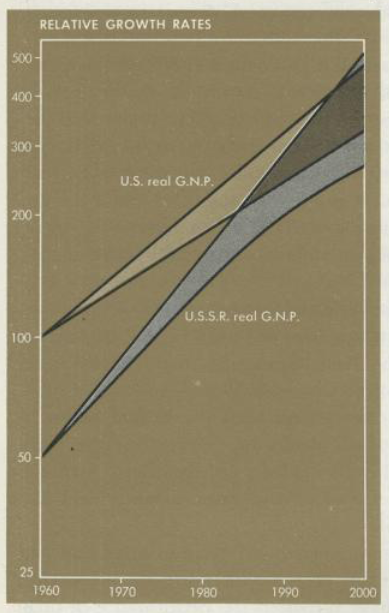Soviet Growth & American Textbooks
In the 1961 edition of his famous textbook of economic principles, Paul Samuelson wrote that GNP in the Soviet Union was about half that in the United States but the Soviet Union was growing faster. As a result, one could comfortably forecast that Soviet GNP would exceed that of the United States by as early as 1984 or perhaps by as late as 1997 and in any event Soviet GNP would greatly catch-up to U.S. GNP. A poor forecast–but it gets worse because in subsequent editions Samuelson presented the same analysis again and again except the overtaking time was always pushed further into the future so by 1980 the dates were 2002 to 2012. In subsequent editions, Samuelson provided no acknowledgment of his past failure to predict and little commentary beyond remarks about “bad weather” in the Soviet Union (see Levy and Peart for more details).
 Among libertarians, this story has long been the subject of much informal amusement. But more recently my colleague David Levy and co-author Sandra Peart have discovered that the story is much more interesting and important than many people, including myself, had ever realized.
Among libertarians, this story has long been the subject of much informal amusement. But more recently my colleague David Levy and co-author Sandra Peart have discovered that the story is much more interesting and important than many people, including myself, had ever realized.
First, an even more off-course analysis can also be found in another mega-selling textbook, McConnell’s Economics (still a huge seller today). Like Samuelson, McConnell estimated Soviet GNP as half that of the United States in 1963 but he showed that the Soviets were investing a much larger share of GNP and thus growing at rates “two to three times” higher than the U.S. Indeed, through at least ten (!) editions, the Soviets continued to grow faster than the U.S. and yet in McConnell’s 1990 edition Soviet GNP was still half that of the United States!
A second case of being blinded by “liberal” ideology? If so, Levy and Peart throw another curve-ball because the very liberal even “leftist” texts of the time, notably those by Lorie Tarshis and Robert Heilbroner did not make the Samuelson-McConnell mistake.
Tarshis and Heilbroner were more liberal than Samuelson and McConnell but offered a more nuanced, descriptive and tentative account of the Soviet economy. Why? Levy and Peart argue that they were saved from error not by skepticism about the Soviet Union per se but rather by skepticism about the power of simple economic theories to fully describe the world in the absence of rich institutional detail.
To make their predictions, Samuelson and McConnell relied heavily on the production possibilities frontier (PPF), the idea that the fundamental tradeoff for any society was between “guns and butter.” Thus, in the 1948 edition Samuelson wrote:
The Russians having no unemployment before the war, were already on their Production-possibilities curve. They had no choice but to substitute war goods for civilian production-with consequent privation.
Note that Samuelson assumes all countries and economic systems are efficient (the Russians are “on” the curve) only the choice of guns versus butter differs. When the war ended, the fundamental tradeoff became one between investment and consumption and since the Soviets invested a greater share of GNP they would naturally consume less but grow faster. Moreover, since the Soviet’s had solved the unemployment problem they were, if anything, more efficient than the U.S. (here we see the Keynesian influence).
Levy and Peart conclude that although ideology may have played a role what arguably made a bigger difference was the blindness imposed by chosen tools. As they write:
We are all constrained by means of models: we gain insight in one dimension by blinding ourselves to events in other dimensions. Competition among models may be necessary to insure that the benefits of the models exceeds their cost.
(Applications to the financial crisis are apposite.)
Addendum: Bryan Caplan also comments. As Bryan notes, a very good economist can use PPFs and still get the story right.